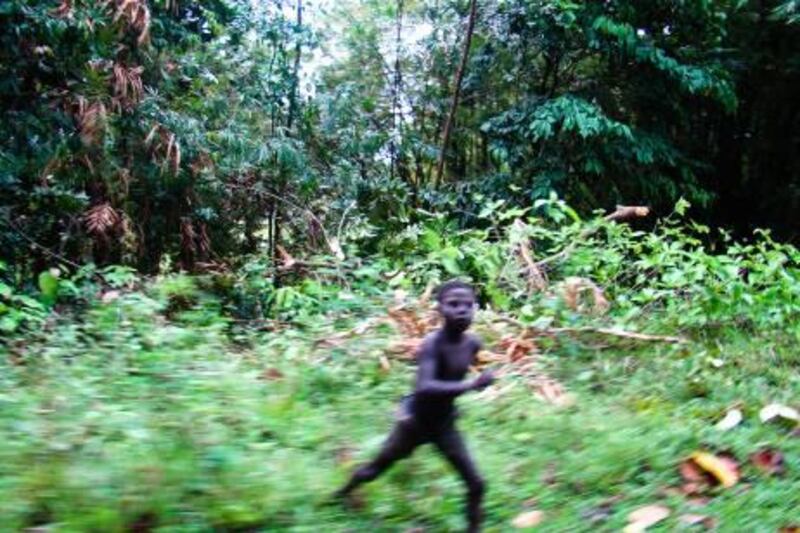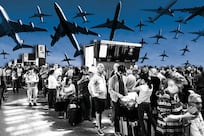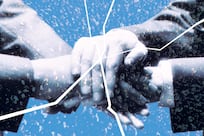"Take photograph, take, take, take." The safari driver is turning in his seat, speaking urgently. "Jarawa," he says, pointing ahead at two women who have stepped out of the forest into the road in front of the car.
Their faces are painted with intricate patterns of dried mud and they are naked from the waist up, carrying short, metal-tipped spears and baskets on their backs. One of the women approaches the car, leans in through the open window, hand outstretched. The driver, alarmed, stands on the accelerator and the car lurches forwards; moments later, the women are gone, back into the jungle, back to their own world.
The driver - his name is Guddu - is excited. "Did you get?" he asks. "If you not get picture, I give you. I have video, too."
This is what the tourists who join the human safaris pay for, this glimpse into another world, a ticket to travel back in time. Here on the Andaman Trunk Road (ATR), which runs through the virgin forest that is home to the Jarawa tribe, the 21st century meets the Stone Age.
Every day the safaris roll through, vast convoys of up to 160 cars and 25 or more buses packed with tourists who have paid anything from Rs3,500 (Dh250) upwards to catch a glimpse of a tribe who only started to emerge from the jungle in 1998.
The Jarawa live in a 1,021-square-kilometre reserve of virgin territory on the island of South Andaman, a tourist paradise set in the Bay of Bengal, belonging to India but closer to Myanmar. They once shunned all outsiders, using their bows and arrows to attack those who tried to make contact. Now they are taking their first tentative steps towards the outside world; they are trusting, innocent and vulnerable. Their innocence is their undoing. Guddu takes out his phone and flicks through it looking for the video. He presses play. There are five young women in the picture and a voice is telling them to dance. "Nacho, nacho [dance, dance]," the voice says. The girls - little more than children, really - jiggle, clap and sway. They are naked apart from red string skirts. They finish and the voice exhorts them to greater effort. "Nacho, nacho."
There are other videos that pass between the drivers and the tourists. In one, another group of young women are also being asked to dance. "Dance, karo na," a voice says and the camera points at a young woman naked but for a bag of yellow grain that she clutches in front of her groin.
The voice is that of a policeman. So, too, is the voice in Guddu's video. The policemen are posted along the road to protect the young women and the rest of the tribe. It costs about Rs15,000 (Dh1,050) to bribe them to get the girls to perform for the cameras. Well-heeled tourists club together and pay eagerly.
***
Every day hundreds of cars line up in front of the gate into the reserve, waiting for their chance. A sign next to the gate lists the times of the convoys - four a day, each way, one roughly every three hours. Another sign lists the rules: no pictures, no contact, nothing that could harm the fragile Jarawa, already struggling to come to grips with the diseases of the outside world which have beset them since they started, tentatively, to come out of the jungle.
The signs mean nothing: the tour operators have assured their passengers that they will get their chance.
The Vyas Brothers shop stands on the edge of the main shopping area of Port Blair, the capital of the Andamans. It sells various handicraft items, some small wooden Jarawa figurines. Rajesh Vyas is behind the counter, explaining how he can arrange for the police to help fix up a meeting. It will cost between Rs10,000 and Rs15,000 for the police alone, another Rs10,000 to Rs15,000 on top of that for everything else - car, driver, some gifts for the Jarawa, biscuits, snacks. It is guaranteed, he promises. For a smaller sum, he will provide a driver who will try to slow down long enough for pictures to be taken. A deal is struck for the latter.
It gets light early in the Andamans. By 5.30am, a line of more than 100 cars and 25 or so buses stretches back from the entry gate to the Jarawa reserve. Tourists mill around, drinking tea, eating snacks from the stalls set up along the roadside and taking photographs of each other on their mobile phones.
A slight drizzle is falling. The convoy is already quite strung out, the vehicles about 50 metres apart, when the women appear by the roadside. There are no police in sight and although the encounter is over in less than 20 seconds, it is long enough to shoot pictures.
Why did the woman reach into the car? Food, says Guddu, or money. Maybe the camera. The police teach them.
The vehicle reaches the jetty for Baratang, the end of the road. Many of the tourists will go on to see the limestone caves that are the purported purpose of the tour; others park up to wait an hour or so before they can set out on the return convoy. On the way back, there are more Jarawa, large groups, men, women and children, standing and sitting by the roadside. They are guarded by police, who wave the vehicles on, but it is clear now that these Jarawa are there by choice because they know the convoys will come. They are not merely being protected from the tourists; they are being protected from themselves.
Look closer at the Jarawa who are sitting by the roadside, says Denis Giles. He is the editor of the Andaman Chronicle, though he seems to spend as much time campaigning on behalf of these misunderstood people. Where are the older people? It is the young who have come out of the jungle, who are fascinated by the outsiders and what they have to offer. As they grow older, they lose interest, realise that the outside world is not for them.
"I believe that one fine day the Jarawa will have to come out and mix. They can't stay in the forest forever. They are aware that there is a world outside the forest. But it should not be a cultural shock to them; they should choose the pace at which they do it," he says.
Instead, they are being thrust ever closer to the tourists and other islanders. They believe the police are protecting them, Giles says, but the reality is that the authorities are using them. He says the police have taught the Jarawa to beg; the police take the money they collect and in return give them some tobacco, which they never previously used, and food. The possibility of abuse is all too obvious and Giles says there have been cases where Jarawa women have given birth to children fathered by outsiders. The babies are not accepted by the tribe and are killed, he says.
In an attempt to reduce contact, the authorities have cut the number of convoys to eight a day. But tourism is important to the local economy and there is no appetite for a total ban. The Indian government would like to close the road completely, but many in the islands regard it as a lifeline along which all their supplies are transported. Switching to a sea route will not be practical until navigational channels, blocked by the earthquake which triggered the 2004 tsunami, can be reopened.
But there are deeper and more complex issues that the authorities are wrestling with, according to Ajai Saxena, the secretary of the Andaman Adim Janjati Vikas Samiti, the island administration's tribal welfare office. It is Saxena's job to try to work out what is best for the Jarawa. His problem is that he is not even sure what is happening within the tribe, let alone how to tackle it.
"They are humans and they are a race which is looking at us and they are at a crossroads and we are not sure what is on their minds," he says.
What the administration wants is time enough to work out what to do. Should it shut the Jarawa off from the world for their own good, or allow those who want to make contact to do so?
Anthropologists think the Jarawa are descendants of some of the first humans to move out of Africa; they have been in the Andamans for tens of thousands of years, possibly reaching the islands by a land bridge. The official head count is 403 after the birth of a boy on November 15.
Pictures from the end of the 19th century show that there have been previous attempts at contact, but even well into the last decade of the 20th century, the Jarawa remained hostile.
It was only in 1998 that they started to emerge from the jungle, after a young man, Enmai, broke his leg while raiding a settlement. His friends left him behind; he was found and taken to hospital for treatment. It was a breakthrough moment: on his return to the jungle, Enmai told others in the tribe that he had been well treated and that there was a strange and fascinating world outside. Others ventured out. Enmai became a minor celebrity; he was even flown to Delhi to meet the prime minister. But Enmai eventually tired of the excitement; he returned to the deep jungle and now does not come out any more.
Most of the Jarawa feel the same way, says Dr Anstice Justin, head of the anthropological survey of India's Andaman operation. "The feeling is not to have interaction with outsiders," Justin says. He points to the fact that the Jarawa are still making and using their bows and arrows as a sign of their desire to continue their culture.
But some members of the tribe have been seduced by the outside world and the results are predictably dispiriting, he says. Some have adopted the vices of outsiders - tobacco, alcohol and chewing betel nuts. He thinks it is a dangerous path, that they should be kept away from the outside world for now. "Forced coexistence would be total genocide for them," he says.
Like many previously uncontacted tribes, the Jarawa are vulnerable to unfamiliar diseases. Already, they have started succumbing to measles and mumps and even malaria.
In 2007, the government established a buffer zone around the Jarawa's reserve - 5km deep on land, 10km from the high tide mark at sea - to try protect the tribe from further interaction with the outside world, in particular a luxury resort being constructed on the very edge of the reserve by the Barefoot company. The case is currently with India's Supreme Court.In the meantime, the resort stands abandoned in a clearing near the shore of Collinpur beach in Constance Bay, on the west coast of the island.
But even the buffer zone proved to be fraught with problems. When India was partitioned after independence, large numbers of Hindus fled what would eventually become Bangladesh. The Indian government settled them in the Andamans, where they built plantations and fished the sea. Many were killed by the Jarawa, but thousands established themselves.
Now they find their plantations off-limits, the sea out of bounds. The only way to gain access is to bribe the police, according to Sapan.
Sapan's family have been growing coconuts and erica nuts on their plantation in Constance Bay since they arrived in 1949. He is sitting in the bow of the boat, looking out towards the Jarawa's forest. A single hut can be seen in a small clearing, but there is no sign of people. The tribe move around from place to place, using temporary shelters. They have larger communal huts hidden deep in the jungle.
The Jarawa come twice a week in a group of 15 to 20, Sapan says. Few of them wear clothes. They ask for food, boiled rice, dal, whatever the villagers are cooking. Sometimes they bring crabs, fish or venison to trade. It is almost 15 years since they started coming to the village. Now they are friendly; it was not always so.
"The Jarawa are very innocent; they don't lie or do mischief. Earlier, even if they attacked they would only come on the full moon. They used to attack using bows and arrows. I never saw them shooting because it was dark but we saw the bodies after they left," he says.
For now, Jarawa and settlers remain on friendly terms, but the buffer zone is placing a strain on the relationship: "Let us live in our village and let them live in their jungle," says Sapan.
His colleague Keshab Mistry pulls on the single oar, propelling the boat towards the white, sandy shore. The problem is the road and the tourism, he says. The tourists don't want to see the limestone caves, he says, they want to see the Jarawa. The tour operators pay off the police and the tribal welfare people. It is all about money.
"They settled us here and now they are saying we must stop using our land," he says bitterly. "We don't understand what is going on. Why can't they let us both live here? We are not against the Jarawa but it is creating a kind of fear. And all this is because of the ATR and the tourism."
•••
SB Tyagi, superintendent of police for South Andaman, sits in a large office and trots out the official line: the convoys have been halved in number, the route is lined with police, the vehicles move at 40kph and no one stops. If the Jarawa come onto the road, the tribal welfare people try to persuade them to go back into the forest.
But there are, he admits, "occasional instances" where the Jarawa come into contact with people who throw bananas and biscuits to them.
"It is not a foolproof arrangement but we are making the effort. People have to understand that if there is a policy of non-interaction there has to be a list of rules. But still some of the drivers and tourists slow down."
He is aware of the allegations against his officers. He makes no attempt to deny them.
"The moment we come across any misdemeanour on the part of our police officers they are dealt with swiftly," he says.
"The tour operators and police are local so there may be situations were they look the other way. There may be incidents where our officers are negligent and we have taken action."
He cites an incident in which an officer was censured for allowing two bus drivers to take Jarawa girls into the jungle. "Who knows why they wanted to," he says. "Some people will have the urge to look at Jarawa women as sexual objects," he says. "Humans will be humans. One can only try to educate them."
The policeman's punishment was to have his future promotion delayed by six months, he adds.
The islands have an official population of 350,000, but, in reality, it is thought to be closer to 600,000. There is a constant flow of incomers from all over India and considerable pressure for land: the concern among activists is that if the Jarawa are assimilated into mainstream society, the jungle will no longer be protected and they will come under pressure from developers to sell their land. Without the jungle, their way of life will disappear and they will drift out of history, just like the Great Andamanese, who once lived in large numbers in the area around the capital, Port Blair, but whose dwindling tribe is now confined to one small island.
"They lost the will to live," says Giles. "The government gave them all facilities, it gave them jobs, but they started drinking and begging. They lost their self-respect and their language and their culture. It is easy for politicians to say integrate, but it is not simple to put it into practice."
Perhaps the Sentinelese, who live in isolation on North Sentinel island, have the right idea, he suggests. The tribe remains hostile, attacking those who come close with bows and arrows. The government made a few attempts to make contact with them, then gave up in 2000. "They remain hostile, so there is no tourism," says Giles. "But the Jarawa have given up their hostility, so now people want to make them a tourist attraction."
Human rights group Survival International has been campaigning for the Jarawa for nearly 20 years. Spokeswoman Sophie Grig says the situation is precarious.
"The Jarawa could easily be decimated or reduced to a state of dependency, as has happened to so many other tribes worldwide," she says. "It is crucial that the Jarawa be able to make their own decisions about the sort of future they want - and that the realistic consequences of these decisions be made clear to them. The reality is that, if they give up their way of life in the forest, they will be at the very bottom of the economic pile."
Before Enmai disappeared once more into the jungle, he spoke at length about the simple life the Jarawa enjoyed, of gathering fruits and hunting pigs with bows and arrows, of fishing for turtles, of climbing trees.
He had seen the world outside the jungle: which did he prefer? Enmai hesitated, tried to be polite, not to offend his hosts. But it was clear where his heart lay.
"The jungle is good," he said, repeatedly.
Gethin Chamberlain is a photojournalist based in South India.










